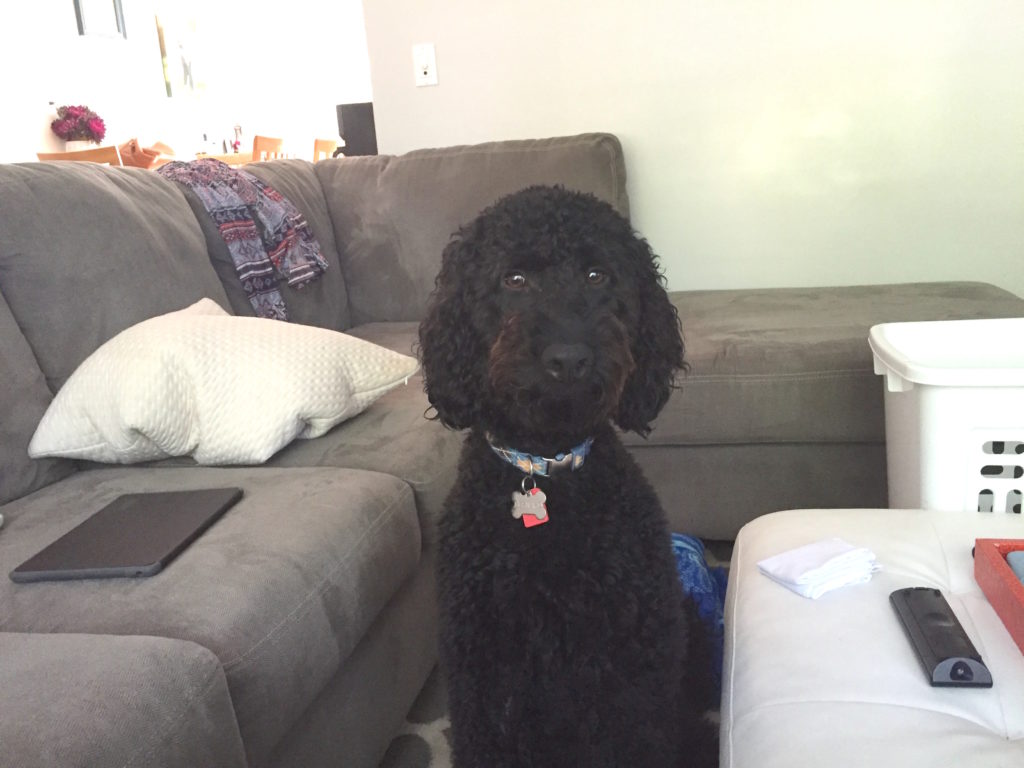Leash Training and Structure Help a High Energy Goldendoodle Calm Down and Listen
By: David Codr
Published Date: August 8, 2016
Bernard is a one-year-old Goldendoodle who lives near us in Omaha. His guardians asked us to stop him from engaging in a few unwanted behaviors; getting excited when people come to the door, leash training, jumping up on people, showing no respect for personal space and only consistently listening to his guardians when they have a treat.
Bernard was very excited when we arrived for the session. He had difficulty controlling himself; jumping up on us, circling around and invading everyone’s person space.
Bernard was still overly excited with us being there as we sat down to discuss what his guardians wanted to achieve for the session.
We always like to give a dog a few minutes to settle down on their own before helping. Some people like to kennel their dog or put them in another room when it is over excited like Bernard was. While this solves the problem temporarily, it does not give the dog the opportunity to learn a new behavior.
David pulled out a leash and showed the guardians how to use it to give Bernard a time out and settle himself down. While this helped calm him down somewhat, Bernard wasn’t what we would classify as completely calm.
While we were discussing Bernard’s behavior, David asked if he nudged his humans to demand attention. When his guardians said that was often the case, David went over a Manding technique he developed called Petting with a Purpose.
When David finished going over the Petting with a Purpose method, Bernard was still too excited for us to effectively work with. This gave David an opportunity to show off one of his favorite energy burning activities for canines; dog skiing.
While the dogskiing only lasted about 10 minutes, it had a profound impact on Bernard. He was noticeable calmer, more relaxed and no longer demanding everyone pay attention to him. Any time you are trying to train or rehabilitate a dog, making sure the dog is sufficiently exercised and has a proper cool down period is extremely beneficial.
Now that Bernard didn’t have so much pent up energy we were ready to get to work. First up, we suggested some rules and structure to help the dog start to see and identify his humans as being authority figures.
Next we went over some non verbal communication cues that David developed after observing hundreds of dogs play and correct one another. After going over these consequences, we tied to identify a real world application to put them to use.
Bernard had a favorite pillow he liked to steal that his guardians took to hiding because they could not get him to leave it alone. David had me use these escalating consequences to demonstrate how to claim an object in a way that the dog understands and respects.
Many people make the same mistake the Bernard’s guardians did; they remove the item and place it where the dog can’t access it. The problem with this approach is that it doesn’t teach the dog how to adopt a new behavior. By claiming the object in this manner and disagreeing with the dog any time it shows interest in the item, we can effectively communicate that it is to be left alone.
Another major concern for Bernard’s guardians was his behavior when people arrived or knocked on the door. Earlier in the session David had gone over a set of escalating consequences to use whenever the dog did something we disagreed with.
We had one of bernard’s guardian’s go outside to play the part of a guest so that David could demonstrate how to use the escalating consequences to keep the dog under control and away from the door.
David recommend that the guardians call or text when they are on their way home so that they can practice this door answering exercise without the added pressure of it being a real guest. Once the guardians get the proper timing and technique down, it should only take a dozen or so repetitions before the dog starts keeping an appropriate distance from the door on its own.
Because Bernard is a higher energy dog, we recommended that they increase his daily exercise regimen. While walking is a great option, there are many others; playing fetch, tag, hide and seek, etc.
His guardians mentioned that they liked to walk Bernard, but he pulled to such an extent it was a very frustrating experience so they didn’t do is as often as they would like to.
David pulled out a martingale collar and showed the guardians how to add a special twist of the leash to give them more control and stop him from pulling. After going over the basics of leash training we headed outside for a real world application.
While the Martingale helped with the control, taking our time and not leaving the home before the dog was in a calm and balanced state of mind made the biggest difference. This is a crucial step that many people skip. But the energy that the dog has before they leave the house, is the same energy they will keep on the walk.
By the end of the session Bernard was much calmer, was looking to his guardians for direction and leadership, kept away from the pillow on his own and was able to control himself. Adding regular exercise, enforcing the rules with good timing and practice at the exercises like answering the door will help Bernard adopt the new behaviors and energy that his guardians want.
Categorized in: Dog Behavior


